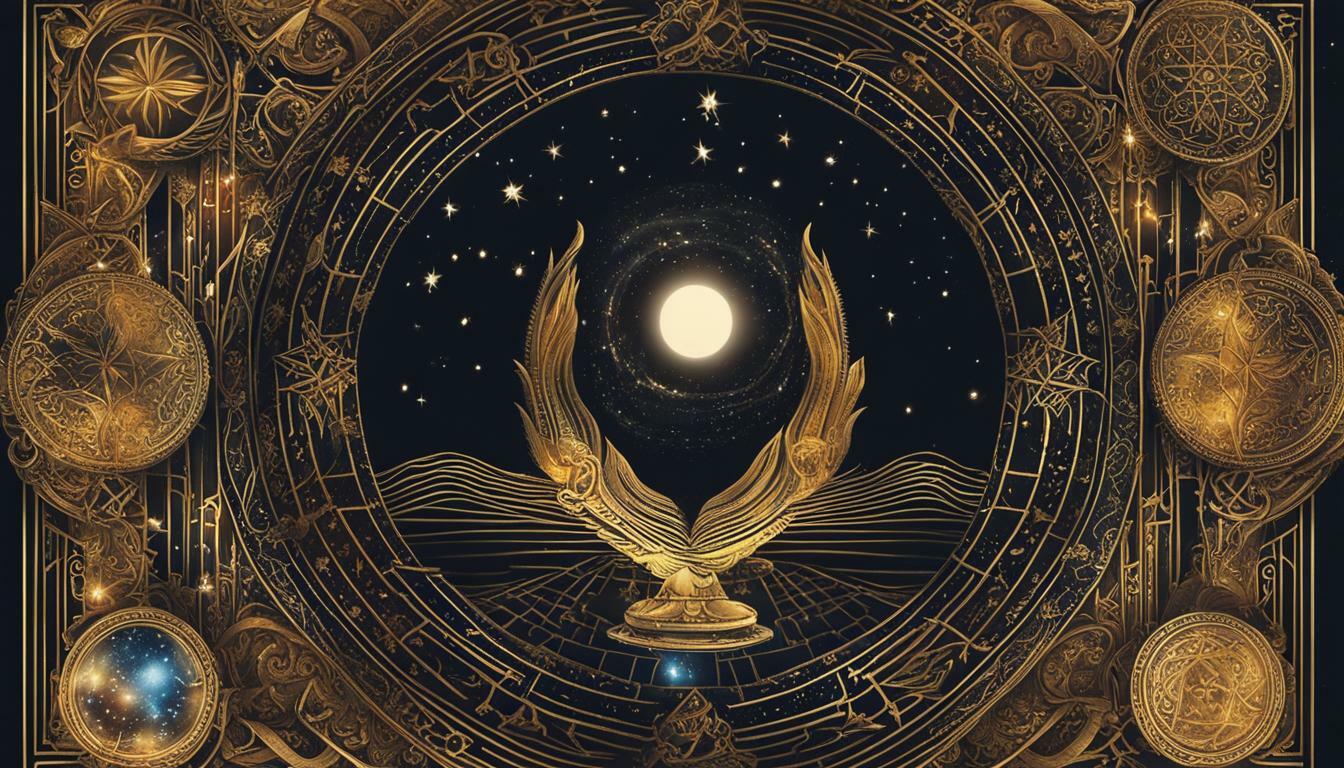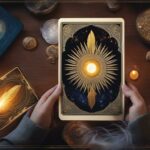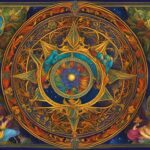Welcome to our beginner’s guide on how to read tarot cards! If you’ve ever been intrigued by the art of tarot card reading and want to learn how to tap into your intuition to unlock the secrets of your future, you’re in the right place. Tarot card reading for beginners can seem overwhelming, but with the right guidance and practice, anyone can develop this empowering skill.
Key Takeaways:
- Understanding the history and symbolism of tarot cards is crucial for beginners.
- Choosing a tarot deck that resonates with you is essential for an effective reading.
- There are various types of tarot readings, such as general readings, question readings, and past-present-future readings, each serving a different purpose.
- Conducting a tarot reading involves setting intentions, shuffling the cards, laying them out in a spread, and interpreting the cards.
- Creating a sacred and positive environment for your tarot readings can enhance your connection with the cards and your intuition.
Understanding the Basics of Tarot
Before we dive into the intricacies of tarot card reading, it’s essential to understand the basic foundations of tarot and its significance in the mystical world. Tarot cards have been used for centuries as a tool for divination, self-reflection, and spiritual guidance. The tarot deck consists of 78 cards, each with its own unique symbolism and meaning.
The deck is divided into two main sections: the Major Arcana and the Minor Arcana. The Major Arcana consists of 22 cards, representing significant life events and themes, such as the Fool, the Magician, and the World. These cards carry a powerful energy and often indicate major shifts or lessons in a person’s life.
The Minor Arcana, on the other hand, consists of 56 cards divided into four suits: Wands, Cups, Swords, and Pentacles. Each suit represents a different aspect of life, such as creativity, emotions, intellect, and material possessions. The Minor Arcana cards provide insight into everyday situations and experiences.
The Tarot Card Meanings for Beginners
To master tarot card reading, it’s essential to familiarize yourself with the meanings behind each card. While there are traditional interpretations, it’s important to note that tarot is a deeply personal and intuitive practice. Trust your instincts and allow the cards to speak to you.
| Card | Meaning |
|---|---|
| The Fool | Representing new beginnings, adventures, and taking risks. |
| The Magician | Symbolizing manifestation, creativity, and personal power. |
| The High Priestess | Signifying intuition, spirituality, and inner knowing. |
| The Empress | Representing abundance, nurturing, and fertility. |
“Tarot reading is an intuitive process that allows you to tap into your inner wisdom and gain insight into various aspects of your life.” – Tarot Master
Remember, the tarot card meanings can vary depending on the context of the reading, the surrounding cards, and your own intuition. Take the time to familiarize yourself with the cards and their symbolism, but don’t be afraid to trust your own interpretations.
Choosing a Tarot Deck
Now that you have a basic understanding of tarot, it’s time to choose a tarot deck that speaks to you and captures your imagination. The deck you choose is a personal decision, as each deck has its own unique symbolism and artwork that resonates differently with each reader.
When selecting a tarot deck for beginners, it’s important to find one that feels intuitive and comfortable to you. Take your time to explore different decks, either in person or online, and pay attention to your initial reactions and connections. Trust your intuition to guide you toward a deck that aligns with your energy and aesthetic preferences.
You may find it helpful to read reviews or seek recommendations from experienced tarot readers, but ultimately, your personal connection should be the deciding factor. Remember, the deck you choose will be a tool for self-reflection and guidance, so it’s crucial that it resonates with you on a deep level.
| Key Considerations for Choosing a Tarot Deck: |
|---|
| Artwork and style: Find a deck with artwork that resonates with you and captures your imagination. |
| Symbolism: Consider the symbolism used in the cards and how it aligns with your personal beliefs and understanding of tarot. |
| Guidebook: Check if the deck comes with a comprehensive guidebook that explains the meanings of the cards and provides suggestions for interpretation. |
| Intuitiveness: Pay attention to how you feel when you hold and handle the cards. Do they feel comfortable and easy to connect with? |
| Availability: Take into account the availability of the deck. Is it easy to find and purchase? |
Remember, there is no right or wrong deck to choose. Each deck offers its own unique perspective and energy, and what matters most is the connection you feel with the cards. Trust your intuition and allow yourself to be drawn to the deck that feels right for you. Happy tarot card reading!
Types of Tarot Readings for Beginners
As a beginner, it’s important to explore different types of tarot readings to find the approach that resonates with you and aligns with your intentions. Tarot readings can provide insight, guidance, and clarity on various aspects of life. Here are some commonly practiced types of tarot readings:
General Readings:
In a general reading, the tarot reader interprets the overall energy and themes surrounding your life at the moment. It offers a broad perspective and can be a good starting point for beginners to gain a general understanding of their current situation.
Question Readings:
Question readings are focused on answering specific questions you may have. You can ask about love, career, relationships, or any other area of concern. The tarot cards provide guidance and insight into your query, helping you make decisions or gain a deeper understanding of the situation.
Theme Readings:
Theme readings focus on specific areas of your life, such as love, money, or personal growth. These readings provide a more in-depth exploration of a particular theme or aspect, allowing you to gain insight and guidance specific to that area.
Past-Present-Future Readings:
As the name suggests, this type of reading offers insights into the past, present, and future aspects of your life. It can help you understand how your past influences your present and how your actions in the present may shape your future.
Yes/No Readings:
Yes/No readings provide simple answers to direct questions. The tarot cards are used to determine whether the answer is a definite “yes” or “no.” These readings can be helpful for quick decision-making or when seeking clarity on a specific matter.
One-Card Readings:
One-card readings involve pulling a single card from the tarot deck and interpreting its meaning. It can be a daily practice to gain insights, guidance, or inspiration for the day ahead. This simple yet effective reading can help you focus on a specific aspect or receive a concise message.
| Type of Tarot Reading | Description |
|---|---|
| General Readings | Interpreting the overall energy and themes surrounding your life |
| Question Readings | Answering specific questions about love, career, relationships, etc. |
| Theme Readings | Exploring specific areas of life such as love, money, personal growth |
| Past-Present-Future Readings | Providing insights into past, present, and future aspects of life |
| Yes/No Readings | Offering simple answers to direct questions |
| One-Card Readings | Interpreting the meaning of a single card for daily insights |
Conducting Your First Tarot Reading
Now that you have your tarot deck and a basic understanding of different tarot readings, it’s time to dive into the actual process of conducting a tarot reading. This step-by-step guide will help you navigate through your first reading with ease and confidence.
1. Set Your Intentions: Before you begin, take a moment to ground yourself and set your intentions for the reading. You can do this by closing your eyes, taking a few deep breaths, and focusing on what you hope to gain from the reading. This will help create a clear energy and focus for your reading.
2. Shuffle the Cards: Begin by shuffling the tarot deck thoroughly. This helps to infuse your energy into the cards and allows them to provide accurate insight. You can shuffle in any way that feels comfortable to you, whether it’s overhand shuffling, riffle shuffling, or simply spreading the cards out and mixing them up.
3. Lay Out the Cards: Once you feel ready, lay out the cards in a spread that resonates with you. There are various spreads to choose from, such as the three-card spread for past-present-future readings or the Celtic Cross spread for more in-depth insight. Select a spread that suits your purpose and arrange the cards accordingly.
4. Interpret the Cards: Take your time to study each card and its position within the spread. Pay attention to the symbols, colors, and imagery on the cards, as well as their placement in relation to each other. Use your intuition and the meanings associated with each card to interpret the message they convey.
Remember, tarot readings are a blend of intuition and symbolism. Trust your inner guidance and let the cards guide you. With practice, you will gain more confidence and develop a deeper connection with your tarot deck.
Creating the Right Environment for Tarot Readings
To truly connect with the energy of the tarot cards and access your intuition, it’s crucial to create a conducive environment that promotes focus, clarity, and positive energy. By setting the right atmosphere, you can enhance the accuracy and effectiveness of your tarot readings.
Here are some essential tips for beginner tarot readers to create the perfect environment:
- Cleanse your space: Before you begin your tarot reading, clear the energy in your space. You can use techniques like smudging with sage or lighting incense to purify the atmosphere.
- Set intentions: Take a moment to set your intentions for the reading. Focus on what you hope to gain from the cards and the guidance you seek.
- Create a sacred space: Designate a specific area for your tarot readings. Decorate it with items that hold personal meaning or resonate with your spiritual practice, such as crystals, candles, or meaningful symbols.
- Quiet your mind: Before you start shuffling the cards, take a few moments to calm your mind. You can practice deep breathing exercises or meditation to center yourself and open up your intuition.
Remember, the environment you create for your tarot readings is a reflection of your inner state. By cultivating a space that is peaceful, sacred, and attuned to your intentions, you set the stage for a more meaningful and insightful experience with the tarot cards.
| Tips for Creating the Right Environment for Tarot Readings |
|---|
| Cleanse your space |
| Set intentions |
| Create a sacred space |
| Quiet your mind |
Is There a PDF Version of the Tarot Cards Reading Guide for Beginners?
Yes, there is a PDF version of the beginner’s guide to tarot card reading available. It serves as a handy tool for those venturing into the world of tarot for the first time. This comprehensive guide provides step-by-step instructions, insightful interpretations, and practical tips to help beginners master the fascinating art of tarot card reading.
Conclusion
Congratulations! You have reached the end of our beginner’s guide on how to read tarot cards. We hope this comprehensive guide has provided you with the knowledge and confidence to embark on your tarot reading journey.
In this guide, we covered the basics of tarot, including the history of tarot cards and the different types of cards in a tarot deck. We also explored the meanings behind tarot cards and how to interpret them as a beginner.
We discussed the importance of choosing a tarot deck that resonates with you, and provided tips on finding the perfect deck for your style and preferences. Additionally, we introduced you to various types of tarot readings suitable for beginners, showcasing the versatility of tarot.
Furthermore, we offered a step-by-step guide on how to conduct your first tarot reading, from setting intentions and shuffling the cards to interpreting them in a spread. We emphasized the significance of creating a positive and sacred space for your tarot readings and having a clear and open mindset.
Now that you have the foundational knowledge and tools, it’s time to dive deeper into the mystical world of tarot. Whether you use tarot for personal growth, self-reflection, or spiritual guidance, remember to approach each reading with curiosity and an open heart. May your tarot journey be filled with wisdom and insight!








